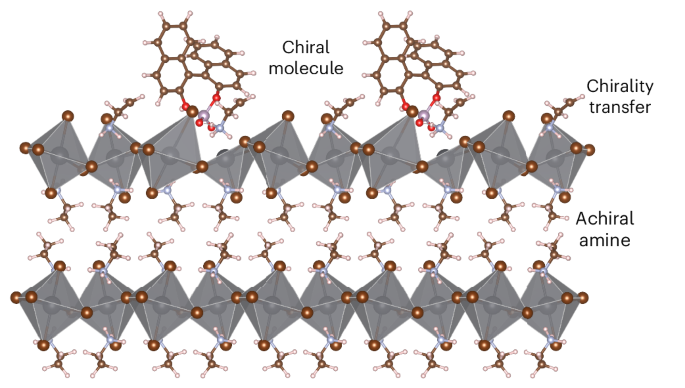2024-10-24 米国国立再生可能エネルギー研究所(NREL)
<関連情報>
- https://www.nrel.gov/news/program/2024/nrel-backed-research-effort-twists-halide-perovskites-from-a-distance.html
- https://www.nature.com/articles/s41557-024-01662-2
- https://www.science.org/doi/10.1126/science.abf5291
低次元ハイブリッドハライド金属半導体における遠隔キラリティ移動 Remote chirality transfer in low-dimensional hybrid metal halide semiconductors
Md Azimul Haque,Andrew Grieder,Steven P. Harvey,Roman Brunecky,Jiselle Y. Ye,Bennett Addison,Junxiang Zhang,Yifan Dong,Yi Xie,Matthew P. Hautzinger,Heshan Hewa Walpitage,Kai Zhu,Jeffrey L. Blackburn,Zeev Valy Vardeny,David B. Mitzi,Joseph J. Berry,Seth R. Marder,Yuan Ping,Matthew C. Beard & Joseph M. Luther
Nature Chemistry Published:25 October 2024
DOI:https://doi.org/10.1038/s41557-024-01662-2

Abstract
In hybrid metal halide perovskites, chiroptical properties typically arise from structural symmetry breaking by incorporating a chiral A-site organic cation within the structure, which may limit the compositional space. Here we demonstrate highly efficient remote chirality transfer where chirality is imposed on an otherwise achiral hybrid metal halide semiconductor by a proximal chiral molecule that is not interspersed as part of the structure yet leads to large circular dichroism dissymmetry factors (gCD) of up to 10−2. Density functional theory calculations reveal that the transfer of stereochemical information from the chiral proximal molecule to the inorganic framework is mediated by selective interaction with divalent metal cations. Anchoring of the chiral molecule induces a centro-asymmetric distortion, which is discernible up to four inorganic layers into the metal halide lattice. This concept is broadly applicable to low-dimensional hybrid metal halides with various dimensionalities (1D and 2D) allowing independent control of the composition and degree of chirality.
キラル誘起スピン選択性が室温スピン発光ダイオードを可能にする Chiral-induced spin selectivity enables a room-temperature spin light-emitting diode
Young-Hoon Kim, Yaxin Zhai, Haipeng Lu, Xin Pan, […], and Matthew C. Beard
Science Published:12 Mar 2021
DOI:https://doi.org/10.1126/science.abf5291

Spin injection sans magnetism
Light-emitting diodes (LEDs) that emit circularly polarized light (spin-LEDs) have potential applications in in three-dimensional displays, bioencoding, and tomography. The requisite spin polarization of the charge carriers is usually achieved with ferromagnetic contacts and applied magnetic fields, but Kim et al. report on a room-temperature spin-LED that relies instead on a chiral-induced spin selectivity organic layer. This layer selectively injected spin-polarized holes into metal halide perovskite nanocrystals, where they radiatively recombined with unpolarized electrons with an efficiency of 2.6%.
Science, this issue p. 1129
Abstract
In traditional optoelectronic approaches, control over spin, charge, and light requires the use of both electrical and magnetic fields. In a spin-polarized light-emitting diode (spin-LED), charges are injected, and circularly polarized light is emitted from spin-polarized carrier pairs. Typically, the injection of carriers occurs with the application of an electric field, whereas spin polarization can be achieved using an applied magnetic field or polarized ferromagnetic contacts. We used chiral-induced spin selectivity (CISS) to produce spin-polarized carriers and demonstrate a spin-LED that operates at room temperature without magnetic fields or ferromagnetic contacts. The CISS layer consists of oriented, self-assembled small chiral molecules within a layered organic-inorganic metal-halide hybrid semiconductor framework. The spin-LED achieves ±2.6% circularly polarized electroluminescence at room temperature.



